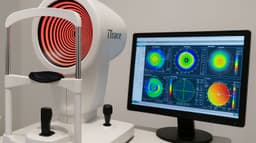
Choosing The Right Clinic For Your Cataract Surgery
Cataract surgery in the UK is a common and well-established procedure aimed at restoring vision for individuals affected by cataracts, which cause clouding of the eye's natural lens. The surgery is typically performed as a day procedure and is considered safe and highly effective. During some surgery options, the cloudy lens is removed and replaced with an artificial intraocular lens (IOL) to improve vision clarity and focus.
Advancements in cataract surgery techniques and technology have significantly improved the outcomes and reduced recovery times for patients in the UK. Today, most cataract surgeries are performed using a technique called phacoemulsification, where the surgeon uses ultrasound energy to break up the cataract, allowing for a smaller incision and faster healing. Patients typically experience improved vision shortly after the surgery, although it may take a couple of weeks for the eyes to fully stabilise. Overall, cataract surgery remains an essential and accessible procedure in the UK, offering patients the opportunity to regain clear vision and significantly enhance their quality of life.
Before choosing an eye clinic for cataract surgery you may want to consider the following:
What Are The Different Types Of Cataract Surgery?
There are several different types of cataract surgery. The most common and widely used techniques eye clinics use include:
Phacoemulsification (Phaco)
Phacoemulsification is the most prevalent and modern cataract surgery technique. It involves making a small incision in the cornea and using an ultrasound device to break up the cloudy lens (cataract) into tiny fragments, which are then gently removed from the eye. After the cataract is removed, an artificial intraocular lens (IOL) is implanted in its place.
Extracapsular Cataract Extraction (ECCE)
This procedure is used when the cataract is too dense to be broken up and removed through phacoemulsification. A larger incision is made in the eye, and the front portion of the lens capsule is removed to take out the cataract in one piece. As with phacoemulsification, an IOL is implanted in the eye after the cataract removal.
Laser-Assisted Cataract Surgery
Also known as femtosecond laser cataract surgery, this technique uses a laser to perform some of the initial steps of cataract surgery, such as creating incisions and breaking up the cataract.
Intracapsular Cataract Extraction (ICCE)
This method involves removing both the cataract and the surrounding lens capsule in one piece. It is now rarely used due to advancements in other surgical techniques.
Manual Small Incision Cataract Surgery (MSICS)
Similar to ECCE, MSICS involves making a larger incision, but it is smaller than the one used in ECCE. The cataract is removed in one piece, and the IOL is implanted through the same incision.
It's essential to note that phacoemulsification is currently the standard of care for cataract surgery due to its safety, effectiveness, and faster recovery times compared to older techniques.

Clear Vision With Little Or No Dependence on Glasses
Cataract surgery is a remarkable procedure that can significantly improve a customer's vision, providing them with clear sight and reducing their dependence on glasses. Modern cataract surgery offers a transformative solution to this problem.
The enhanced visual clarity and reduced dependence on corrective eyewear can significantly enhance a person's quality of life, enabling them to engage in activities they love without the inconvenience of constantly reaching for their glasses.
Furthermore, cataract surgery is typically a quick and safe procedure with a short recovery time. Customers often notice a significant improvement in their vision shortly after the surgery, and any minor discomfort experienced during the recovery period is usually temporary. With the vast majority of cataract surgeries resulting in successful outcomes, the procedure has become one of the most commonly performed and reliable surgeries worldwide.
Cataract surgery offers a life-changing opportunity for individuals suffering from cataracts to regain clear vision with minimal or no dependence on glasses. With advancements in technology and personalised lens options, the procedure has become highly effective and safe, allowing customers to enjoy improved visual acuity and enhanced freedom in their daily activities.

What Are The Best Cataract Implants For Your Eyes?
The choice of the best cataract implants, also known as intraocular lenses (IOLs), depends on various factors, including the individual's eye health, lifestyle, and visual needs. There is no one-size-fits-all answer, as different IOLs offer different benefits. Here are some common types of cataract implants, each with its advantages:
Monofocal IOLs
Monofocal IOLs are the standard and most commonly used type. They provide clear vision at a single fixed distance, usually set for either near, intermediate or distance vision. Most people who choose monofocal IOLs will still need glasses for certain activities, such as reading or driving, depending on the focal length chosen for the IOL.
Multifocal IOLs
Multifocal IOLs are designed to provide clear vision at multiple distances, reducing the dependence on glasses for activities like reading, using a computer, or seeing objects at a distance. These IOLs have different zones that allow for simultaneous vision correction at various focal lengths. While many people achieve good results with multifocal IOLs, some may experience mild visual disturbances like halos or glare, especially in low-light conditions.
Accommodating IOLs
Accommodating IOLs are designed to mimic the eye's natural lens, adjusting its position to focus on objects at different distances. These lenses provide a more seamless transition between near and far vision, reducing the need for glasses. Some individuals may still require glasses for certain tasks or in specific lighting conditions.
Toric IOLs
Toric IOLs are specifically designed to correct astigmatism. They offer improved clarity and reduced distortion for people with significant astigmatism. However, like monofocal IOLs, they typically correct vision at a single distance, so glasses may still be required for near or intermediate vision.
Extended Depth of Focus (EDOF) IOLs
EDOF IOLs are a newer type of lens that provides a continuous range of vision from near to intermediate, and sometimes even to distance. They aim to reduce visual disturbances common with multifocal IOLs while offering a more extended range of functional vision.
The best cataract implant for your eyes will be determined through discussions with your ophthalmologist. They will consider factors such as your visual requirements, eye health, astigmatism, and other individual considerations to recommend the most suitable IOL for you.
Correction Of Astigmatism With Toric Lenses
“Correction of astigmatism with toric lenses," refers to a specific type of intraocular lens (IOL) used during cataract surgery or refractive lens exchange to address both cataracts and astigmatism.
Astigmatism is a common refractive error caused by an irregular shape of the cornea or the lens inside the eye. Instead of having a uniform curve like a basketball, the cornea or lens may have an irregular shape more akin to a baseball. This irregularity causes light to focus on multiple points on the retina, leading to blurred or distorted vision at various distances.
Toric lenses are specially designed IOLs that can correct astigmatism in addition to replacing the clouded natural lens affected by cataracts. Unlike standard spherical IOLs, which have the same power in all meridians, toric lenses have different powers in different meridians to compensate for the astigmatism.
During cataract surgery or refractive lens exchange, the surgeon will make precise measurements of the patient's corneal curvature and astigmatism to determine the proper power and alignment of the toric lens. Once implanted in the eye, the toric lens aligns with the specific axis of astigmatism, correcting the irregular focus of light and providing clearer vision at all distances.
It's important to note that toric lenses are effective for individuals with significant astigmatism. However, they typically correct vision at a specific distance, often for distance vision, and may not provide full correction for both near and far vision simultaneously. As a result, some patients may still require reading glasses or corrective eyewear for certain tasks or activities.
The decision to use toric lenses for astigmatism correction is based on the patient's eye health, the severity of astigmatism, and their visual needs. An ophthalmologist or eye surgeon will evaluate each individual case and recommend the most appropriate treatment plan to optimise visual outcomes and improve the overall quality of vision after cataract surgery or refractive lens exchange.
Will Both Eyes Be Operated Together?
A good eye clinic and ophthalmologists will perform cataract surgery on both eyes during the same surgical session. This is commonly referred to as "bilateral cataract surgery" or "simultaneous cataract surgery."

Under normal circumstances, a person may develop cataracts in both eyes, but the severity of cataracts can vary between eyes. Some individuals may have cataracts in both eyes that significantly affect their vision and quality of life, making it more practical and efficient to address both eyes at the same time.
There are several advantages to undergoing bilateral cataract surgery:
Convenience
Addressing both eyes in a single session means the patient only needs to go through pre-operative evaluations, surgery, and post-operative care once, which can be more convenient and less time-consuming.
Symmetry
By having both eyes corrected simultaneously, the visual outcomes are often more balanced and symmetrical, leading to a more consistent visual experience.
Reduced Recovery Time
Instead of waiting for one eye to heal before undergoing surgery on the other eye, bilateral cataract surgery allows for a shorter overall recovery time.
One-Time Anesthesia
Anaesthesia is administered only once for both eyes, which can be beneficial, especially for patients who may have health conditions that require extra consideration during anaesthesia.
However, bilateral cataract surgery may not be suitable for everyone. An ophthalmologist will assess the patient's overall health, eye health, and other individual factors to determine if it is safe and appropriate to perform surgery on both eyes at the same time. In some cases, due to specific eye conditions or medical considerations, the surgeon may choose to perform cataract surgery on each eye on separate occasions.
As with any surgical procedure, it is essential to have a thorough discussion with the eye surgeon to understand the risks, benefits, and potential outcomes of bilateral cataract surgery and make an informed decision based on the individual's unique circumstances.
Eye Clinic Etiquette And Patient Care
Patient and eye clinic etiquette is crucial for fostering a positive and productive relationship between patients and their surgeons. In clinics where the first appointments are held by the surgeon, it's an opportunity for patients to establish a direct and personal connection with their eye care provider from the beginning. This initial meeting allows the surgeon to understand the patient's unique eye health needs, medical history, and visual goals. Patients, on the other hand, can feel more at ease sharing their concerns and asking questions directly to the surgeon, promoting better communication and trust.
Providing patients with the surgeon's telephone number is a sign of accessibility and attentiveness. It allows patients to reach out in case of any urgent questions or post-operative concerns. Open communication channels facilitate a smoother journey through the entire process, ensuring that patients feel supported and cared for during their eye care journey.
Continuity of care is essential in eye clinics, and seeing the same surgeon on follow-up visits reinforces this aspect. When patients see the same surgeon for their post-operative appointments, it enhances continuity, as the surgeon is already familiar with the patient's history and progress. This consistency enables the surgeon to provide personalised care, track the patient's recovery effectively, and address any emerging issues promptly.
Involving the patient in the decision-making process is an integral part of patient-centered care. The surgeon should thoroughly explain the available treatment options, potential risks, and expected outcomes, allowing the patient to make informed decisions about their eye health. This approach empowers patients to take an active role in their treatment plan, leading to increased satisfaction and better compliance with post-operative instructions.
Moreover, establishing trust, open communication, and shared decision-making lays the foundation for a successful outcome and a strong doctor-patient relationship, ensuring that the patient's vision and eye health are prioritised at every step of the journey.

Does The Clinic Have A State-Of-The-Art Operating Theatre?
An eye clinic equipped with modern and state-of-the-art equipment, including a cutting-edge operating theatre, offers numerous advantages that can significantly reassure patients about the quality of their eye care and overall experience. When patients are aware that the clinic utilises the latest technology, it instils confidence and peace of mind, knowing that they are receiving the most advanced and effective treatments available.
Modern equipment in an eye clinic allows for more accurate and precise diagnostics. Advanced imaging and diagnostic tools can detect eye conditions at their earliest stages, enabling early intervention and preventing potential complications. Whether it's diagnosing cataracts, glaucoma, retinal issues, or other eye conditions, having access to top-notch equipment enhances the accuracy of diagnosis and helps guide appropriate treatment plans.
The presence of a modern operating theatre further assures patients about the safety and efficacy of surgical procedures. These cutting-edge theatres are designed to maintain strict sterility, reduce infection risks, and optimise surgical outcomes. Advanced surgical tools and technology, such as phacoemulsification machines for cataract surgery allow for minimally invasive procedures with faster recovery times and reduced risk of complications.
Moreover, modern equipment in an eye clinic often translates to enhanced patient comfort during various diagnostic tests and treatments. For instance, newer devices for eye examinations may be more comfortable and non-invasive, leading to a more pleasant experience for patients, especially for those who may be anxious about eye exams.
Having access to the latest technology can also mean staying at the forefront of innovative treatments and therapies. Patients can feel reassured knowing that their eye clinic is committed to continually advancing its practices and adopting new, evidence-based techniques for better patient outcomes.
Discover The Future Of Eye Care At My-iClinic!
Are you looking for a cutting-edge eye clinic that provides the latest advancements in eye care technology and a state-of-the-art operating theatre? Look no further than My-iClinic! We are dedicated to bringing you the best in modern eye care, ensuring you receive the highest quality treatment for your vision needs.
At My-iClinic, our commitment to excellence starts from the moment you step through our doors. With a team of skilled and experienced eye care professionals, we offer personalised care, guiding you through the entire journey towards improved vision and eye health.
Rest assured that our clinic is equipped with modern equipment, including advanced imaging and diagnostic tools, ensuring accurate and precise diagnoses. From detecting early signs of eye conditions to offering innovative treatments and therapies, we stay at the forefront of eye care technology to bring you the best solutions available.
Our state-of-the-art operating theatre sets the stage for safe and efficient surgical procedures. Whether it's cataract surgery or other eye surgeries, our cutting-edge facilities ensure minimised risks, quicker recovery times, and optimal surgical outcomes.
We believe that every patient deserves to be involved in their own eye care decisions. Our patient-centred approach ensures you are informed about your treatment options and actively participate in developing a tailored plan that suits your unique needs and lifestyle.
Take control of your eye health today and experience the future of eye care at My-iClinic! Schedule your appointment now and entrust your vision to a clinic that combines advanced technology, expertise, and compassionate care. Your eyes deserve the best, and we are here to provide it. See clearly, see confidently – at My-iClinic!
Find out more by Speaking to our team









